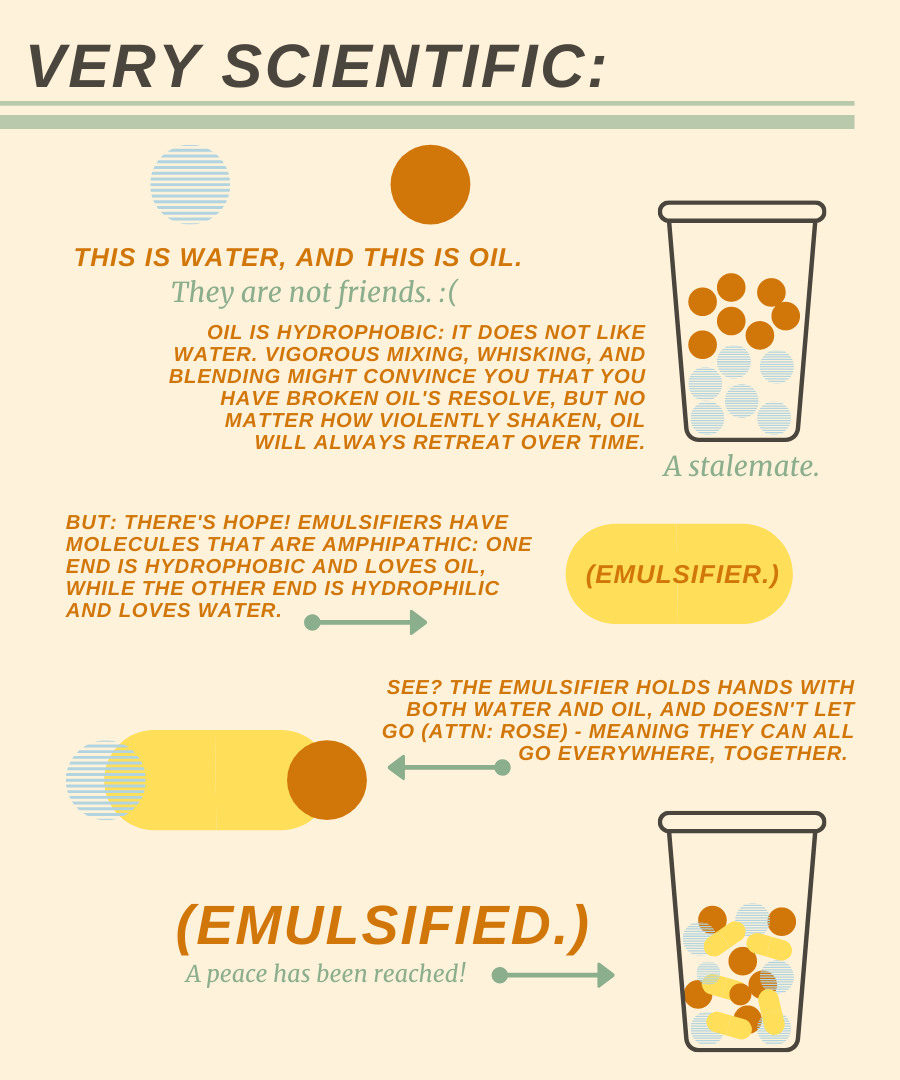5 Common Types of Emulsifier In Food and Their Uses
Reveal the Benefits of Utilizing an Emulsifier in Food for Boosted Culinary Experiences
Emulsifiers are usually neglected yet necessary components in cooking techniques. They help with the blending of diverse ingredients, enhancing both flavor and appearance. By ensuring stability, emulsifiers stop the unsightly splitting up of mixtures. Their flexibility spans numerous applications, from sauces to dressings. Recognizing their function can result in significant enhancements in food high quality and presentation. What certain advantages do emulsifiers supply that can change day-to-day dishes into phenomenal culinary experiences?
Comprehending Emulsifiers: What They Are and Just how They Work
Emulsifiers play an important duty in the food sector, working as representatives that facilitate the mixing of water and oil, 2 compounds that usually do not mix. These compounds possess both hydrophilic (water-attracting) and hydrophobic (oil-attracting) residential or commercial properties, permitting them to support combinations by minimizing the surface tension between the 2 phases. Usual emulsifiers consist of lecithin, mono- and diglycerides, and certain healthy proteins.
When contributed to food items, emulsifiers produce a stable solution, protecting against separation and guaranteeing a consistent appearance - Emulsifier In Food. They are essential in numerous applications, varying from salad dressings and mayo to ice lotion and sauces. By maintaining the stability of blends, emulsifiers not only enhance the visual charm of food but likewise improve mouthfeel and consistency. Their capacity to maintain emulsions makes them vital in modern food solution, contributing considerably to the quality and service life of numerous items
The Function of Emulsifiers in Taste Improvement
While commonly neglected, emulsifiers significantly add to taste improvement in food. They play an essential function in improving the overall taste experience by assuring that taste substances are evenly dispersed throughout a dish. By supporting emulsions, such as sauces or dressings, emulsifiers avoid the splitting up of oil and water, permitting flavors to blend with each other better. This consistent circulation not only escalates the taste yet additionally guarantees that each bite is regularly flavorful.
Additionally, emulsifiers can improve the perception of specific flavors, making them more noticable on the palate. They might interact with certain ingredients, assisting to launch unpredictable taste substances that add to a meal's fragrant profile. Subsequently, using emulsifiers can greatly raise the culinary experience, transforming easy recipes right into facility and wonderful taste trips. Their subtle yet impactful role in flavor improvement must not be taken too lightly in the art of cooking.
Emulsifiers and Appearance: Developing Creamy and Velvety Cuisines
The impact of emulsifiers expands beyond flavor improvement to the domain of appearance, where they contribute in developing velvety and creamy meals. By assisting in the consistent distribution of fats and water, emulsifiers allow the formation of secure solutions, causing a glamorous mouthfeel. This is particularly evident in items like mayo, sauces, and dressings, where a smooth, luscious consistency is desired.
Emulsifiers such as lecithin and mono- and diglycerides function to decrease surface area stress in between components, permitting an unified mix that boosts the sensory experience. The velvety appearance attained with emulsification can elevate meals, making them a lot more attractive and delightful. Additionally, the capability to develop a silky appearance enables cooks to include different ingredients without endangering uniformity, leading to ingenious culinary developments. Basically, emulsifiers play a vital role in transforming normal meals right into amazing culinary experiences through appearance improvement.
Security Issues: Just How Emulsifiers Prevent Separation
A vital facet of cooking emulsifiers is their ability to stop splitting up, guaranteeing that site here products preserve their desired structure and appearance in time. Emulsifiers work by maintaining blends of oil and water, which normally have a tendency to divide because of distinctions in thickness and polarity. By reducing surface tension at the oil-water interface, emulsifiers promote the click for source formation of steady emulsions, enabling an uniform circulation of active ingredients.

Typical Emulsifiers in Cooking and Their Applications
Comprehending the different emulsifiers frequently used in cooking discloses their significant duties in improving food structure and security. Lecithin, stemmed from egg yolks or soybeans, is widely utilized in mayonnaise and salad dressings, giving a velvety consistency. Mustard, likewise an emulsifier, aids in supporting vinaigrettes while imparting flavor.


An additional preferred emulsifier is xanthan gum tissue, frequently made use of in gluten-free baking and sauces for its thickening homes. Guar gum offers a similar objective, enhancing the structure of gelato and dairy items.
Mono- and diglycerides, frequently discovered in refined foods, assistance improve service life and preserve texture. Ultimately, casein, a milk protein, is made use of in cheese-making and velvety sauces, adding to a smooth mouthfeel. Each of these emulsifiers plays a necessary role in cooking applications, ensuring preferable textures and preventing separation in varied food items.
Regularly Asked Questions
Are Emulsifiers Safe for People With Food Allergies?
Emulsifiers can be risk-free for individuals with food allergies, depending upon the specific emulsifier made use of. It is essential to identify the source of the emulsifier, as some might activate allergies in sensitive individuals.
Exactly How Do Emulsifiers Impact the Nutritional Web Content of Food?
Emulsifiers can influence the nutritional web content of food by enhancing nutrition absorption and improving appearance. Their presence might also thin down specific nutrients, depending on the food matrix, potentially modifying general dietary value.
Can Emulsifiers Be Utilized in Vegan Food Preparation?
Emulsifiers can be properly used in vegan food preparation, offering texture and stability to recipes. Plant-based emulsifiers like lecithin, derived from soy or sunflower, aid mix active ingredients, enhancing the overall high quality of vegan cooking creations.
What Are the Ecological Impacts of Emulsifier Manufacturing?
The ecological impacts of emulsifier manufacturing often include deforestation, water pollution, and high power consumption. Additionally, some resources of emulsifiers can add to biodiversity loss, raising issues concerning sustainability in food manufacturing practices.
Just How Do Emulsifiers Contrast to Natural Thickeners in Food Preparation?
Emulsifiers supply smoother structures and enhanced security compared to all-natural thickeners, which can impart unique flavors - try this web-site Emulsifier In Food. While emulsifiers boost mouthfeel and appearance, all-natural thickeners offer even more health advantages and can add to the dish's flavor profile
When added to food items, emulsifiers produce a secure emulsion, avoiding separation and ensuring a consistent texture. While commonly ignored, emulsifiers considerably contribute to flavor improvement in food products. Comprehending the numerous emulsifiers typically made use of in cooking discloses their considerable roles in boosting food structure and security. Emulsifiers can be secure for individuals with food allergic reactions, depending on the certain emulsifier used. Emulsifiers can affect the dietary material of food by improving vitamins and mineral absorption and enhancing structure.